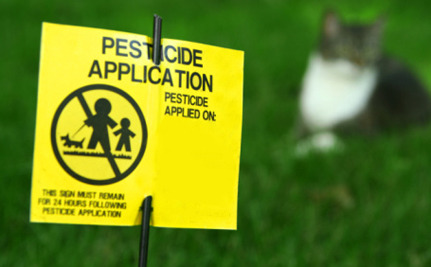Veterinary clinics receive tens of thousands of calls each year from people whose pets have had potentially hazardous contact with insecticides, weed killers, pet-toxic plants, and other harmful substances.
It doesn’t have to be that way. Here are 10 common-sense ways to keep your pet safe outdoors.
1. Get to know the names of the plants in your yard to determine if they’re safe. And when you’re designing or planting, avoid any outdoor plants that are toxic to cats and dogs, such as Sago Palm, Azalea and Rhododendron. ASPCA poison Control has a complete list of plants that are toxic to animals. Plants can cause anything from local irritation and drooling to seizures and death.
2. Keep your pet out of your neighbors’ yards if you don’t know exactly what plants, flowers, and possibly harmful items like insecticides and poisons they have. Alternatively, talk to your neighbors and educate them about the possible backyard dangers for pets. If I had done this, I would still have my adorable white Snowshoe.
3. Speaking of insecticides and pesticides, these are definitely not meant to be consumed by anyone. If you must use them, lower your chances of problems for your pet by following label directions, selecting lower toxicity pesticides, removing your pets, their toys and their food and water from the area to be treated, and keeping them out of treated areas until the pesticide has dried completely. Better yet: find a natural, poison-free alternative.
4. Fertilizers and plant foods can be great to keep our yards and indoor plants healthy and green, but they too can be deadly for your pet’s digestive tract. Be sure to allow the suggested waiting period before letting your pet head outside. Same thing inside: find a way to keep your pet away from plants treated with any plant food, to avoid stomach upsets and gastro-intestinal problems.
5. Garden tools should also be stored in a secure place, and not left out on the ground. We all know how curious our animals are, and those shears, rakes, and trowels can definitely cause serious injury to a pet. There’s even a risk of tetanus if a rusty tool pierces the skin of a cat or dog.
6. Compost can be great for your yard, but I make sure that my compost bins are closed and pet proof. That’s because some of the food waste I throw in there can be dangerous for pets: grapes, mushrooms, onions, garlic, coffee grounds, and moldy food are just some of the food waste products that can cause big problems for your cat or dog.
7. Cocoa mulch, a by-product of chocolate, is often used in landscaping, but the ASPCA’s Animal Poison Control Center lists cocoa mulch as a hazardous garden substance. Ingesting this substance can bring on vomiting and diarrhea in some dogs as well as a rapid heart rate, muscle tremors and acting hyper. The substance is also toxic to cats, but they are much less likely to eat it. Try using mulch alternatives such as cedar, shredded pine or hemlock bark.
8. Fleas and ticks are always waiting to jump on to your pet, or so it seems. Your vet is the one to consult about the best options for controlling these pests but pet owners need to do their part too. It’s important to keep your grass mowed and trim, since fleas and ticks lie in wait in tall brush and grass. If you do find a tick on your cat or dog, learn how to properly remove a tick from your pet here.
9. A backyard pool is an obvious risk to your pets. Drowning is one hazard, but also those pool chemicals can make your pet very sick. Animals are curious, and they like to sniff and taste whatever happens to be lying around. Drinking pool chemicals, however, will bring on vomiting, breathing difficulties and maybe even loss of consciousness, so keep a careful eye on your cat or dog.
10. Children: I hesitate to bring this one up, but I have seen how young children can chase and terrify a small animal. I’ve also witnessed children throwing food and other objects over a neighbor’s fence, to attract the attention of the Golden Labrador on the other side. And of course if you do keep your dog safe in the backyard, he’s not safe anymore if your kids forget to latch the gate. Keep an eye on those young ones!
Read more: http://www.care2.com/causes/10-ways-to-keep-your-pet-safe-in-your-backyard.html#ixzz3eM6n0i71
Source: 10 Ways To Keep Your Pet Safe In Your Backyard | Care2 Causes

